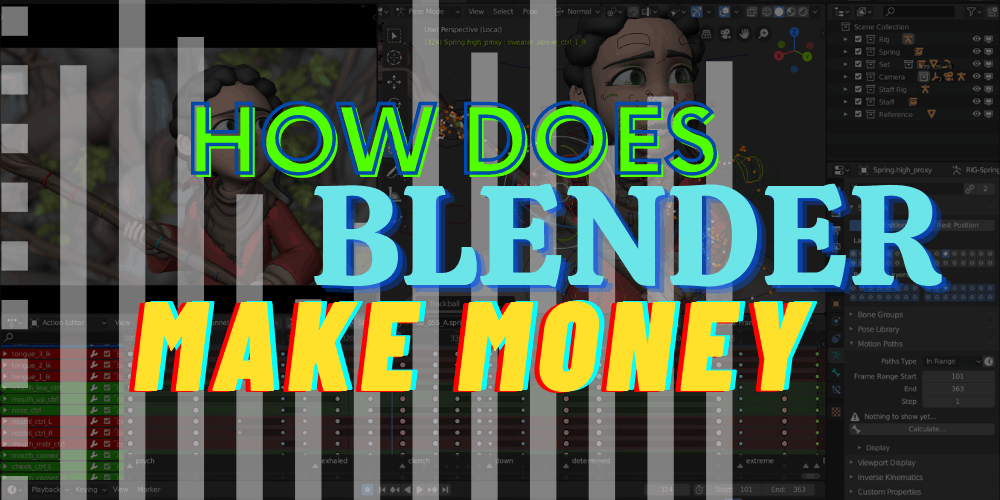Blender is a free and open-source 3D graphics application software product.
Its use covers a wide variety of purposes, including television commercials, short films, feature films, game development, visual effects, education, and industrial design.
The Blender Foundation hosts an annual, week-long conference, the Blender Conference, to which all can attend.
So how does Blender make its money? Read on to find out.

Blender is from the mind of a Danish cartoonist, programmer, and current project lead, Ton Roosendaal.
An international team of volunteers from around the world work on the project.
Blender is an open-source software product available for all major operating systems.
The platform is free and available for use under the terms of the GNU General Public License.
Blender is easy to use but powerful.
It comes with a broad and deep feature set, making it suitable for everything from basic tasks to advanced technical challenges.
Blender is well suited to the demands of the modern production pipeline.
It includes powerful tools for animation, modeling, simulation, motion tracking, compositing, and rendering.
How Does Blender Make Money?
Blender is a grass-roots project. It is free and open-source software. Being free software, Blender is not for sale.
The Blender Foundation receives no money from selling Blender.
So, how does Blender make money? Volunteers maintain the platform and the only revenue stream is donations.
The Blender foundation can receive donations, but Blender is not a non-profit, so donations are not tax-deductible.
The Blender Foundation is based in Amsterdam, The Netherlands, and is not a charity organization.
It is a foundation that seeks to support and promote the development of Blender.
Any Individual or Company can contribute to the Blender Development Fund starting at 5 Euros per month.
There are currently 5533 individuals and 53 corporate members, as stated on their website.
How Much Money Does Blender Make

There is no way to know how much money Blender makes.
There is no external company that tracks and reports Blender revenue figures.
The Blender Foundation is a not-for-profit organization and does not release financial figures.
Any public financial reports of Blender revenue are estimates only.
The Blender Foundation is a grass-roots organization, with a small staff of paid employees.
The Blender Foundation supports Blender, but no one is getting rich from the platform, The Foundation does not pay anyone a salary to work on Blender.
Therefore, the Blender Foundation does not make any profit.
The Blender Foundation is a non-profit organization.
It does not disclose financial reports and does not need to disclose financial reports.
On the official webpage of the Blender Foundation, it reported US$155,400 monthly contributions from its members of the Development Fund, which is US$1,864,800 annualized.
Blender History
Blender began as a research project from the Netherlands Institute for Multimedia and Digital Special Effects in 1996.
It was created due to the lack of open-source 3D software.
The developers of Blender borrowed the code of a 3D file format from a defunct project called Yafray.
The founders of Blender are Ton Roosendaal, Erwin Coumans, and Rien Poortvliet.
The idea to develop Blender began in 1995 when Ton Roosendaal got the opportunity to work on a short animation film.
He first decided to create a 3D engine for his own use, but when the film was canceled he opted to release the engine as a product.
Upon realizing it was not easy for him to release it as open-source, so he decided to make it available from a web page.
Roosendaal also wanted to avoid the word “Blender” in the name to make it more generic, so he eventually settled on the name of the best available substitute: “Fluid”.

The History of Fluid
Fluid was originally based on SETI@home’s animation system, Fluid Animation Software Technology Initiative (FASTI), Ton had used this in his earlier projects.
The engine was written in C++ and designed to work on different platforms (Unix, Windows, and MacOS).
The engine was released in September 1996.
In 1997 Ton decided to write a new 3D animation software from scratch and make it public, this time making it open source as well.
The engine was designed to be powerful and easy to use. The development went quickly, and the engine was named “Blender”.
The creators chose the name Blender because it was short, funny, and memorable.
In 1998, after a year of development, the engine was stable enough for public release.
Ton decided to release Blender as open source. The Blender Foundation was founded, and the website (www.blender.nl) was launched.
Ton’s company, Nozmo, began selling the software with 3D models and animations.
Erwin Coumans joined the Blender team and implemented the Cycles rendering engine, which would later become the standard rendering engine for Blender.
Rien Poortvliet joined the Blender Institute in 2002 and began writing a new 3D modeling kernel for Blender.
In 2002 the Blender Foundation became a non-profit organization.
Who Owns Blender

The Blender Foundation owns the Blender trademark. Blender is a non-profit organization that is open to anyone with an interest in its goals.
The Blender Foundation has numerous individual members all over the world, as well as organizational members in multiple countries.
The Blender Foundation runs via a board of directors.
The general membership elects these individual to serve on the board.
The board members make sure the organization is in line with its legal requirements, is financially solvent, and is progressing with the goals of the foundation.
The Chairman of the Blender Foundation is Ton Roosendaal.
What Is Blender Worth
As the Blender Foundation is a non-profit organization, and the main source of income comes from donations, we are unable to determine the Company’s valuation.
However, if we extrapolate the currently monthly donations the foundation receives and make the assumption that the Company’s operating model is similar to that of a SaaS (Software-as-a-Service) Company with recurring revenues, we can estimate that based on a Revenue Multiple of 8.2 times ARR (Annual Recurring Revenue), which is the median public SaaS company valuation multiple.
Using that multiple, we can estimate that the valuation of Blender is worth approximately US$15,290,000.
How Can Blender Make Money In The Future

There are multiple ways that Blender can generate a significant amount of revenue if it chooses to monetize its massive user base.
Given the success of the Blender Cloud, Blender could become an intermediary (like Dropbox, Google, or Amazon) between companies who want to do 3D cloud computing and the people who would like to do it.
Since Blender is so popular, companies are likely to use Blender for their cloud computing.
This would lead to more people joining Blender, which would increase Blender’s income.
People who use Blender Cloud might also have to pay for anything they produce with Blender Cloud.
This includes 3D models, animations, videos, and more.
Furthermore, there could be a Blender Cloud API that allows people to use Blender Cloud in their own applications.
In the end, Blender could become an intermediary between the people who want to use 3D cloud computing and the companies who would like to offer it.
How Does Blender Make Money: Final Thoughts
Blender has a lot of potential for making money. The Blender Cloud is already very popular and can help to make good profit.
As an open-source software product, Blender is free for anyone to use, so Blender could also make money by charging for the other Blender products from Blender Cloud users.
Blender can help initiate sales from any creations on the platform to companies who want to use them.
This means that Blender is likely to help people make lots of money.


 Tags:
Tags:










